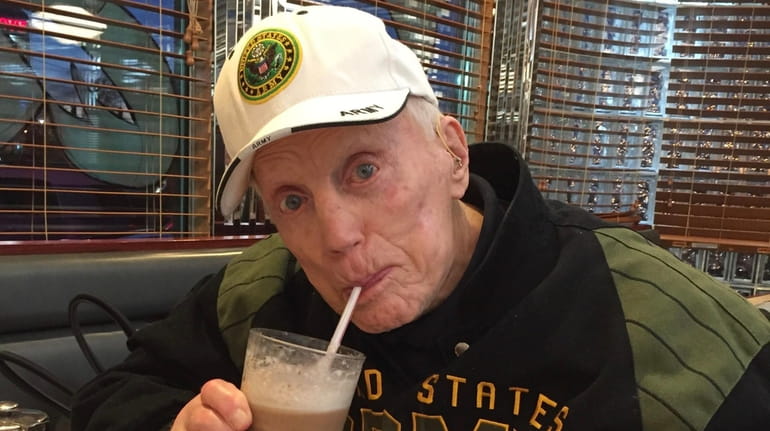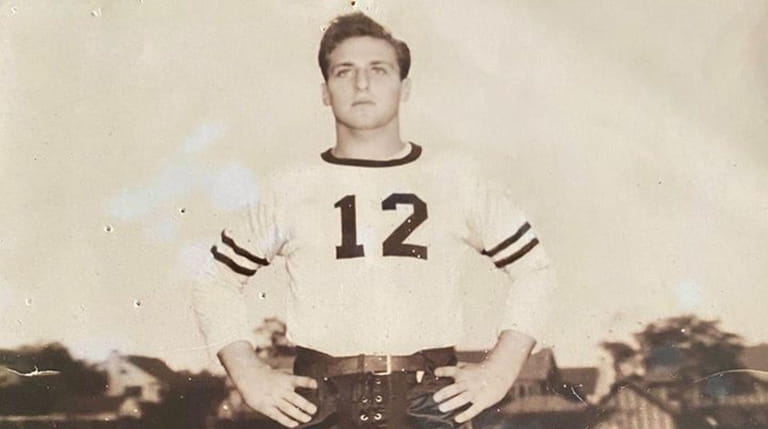At the Long Island State Veterans Home, communication is key

Howard Extract, who died April 19 at the age of 96 while a resident at the Long Island State Veterans home, at the Lake Grove Diner in 2017. Credit: David Leiman
When former Great Neck State Assemb. Michelle Schimel’s 96-year-old father, Howard Extract, passed away this week, Schimel had nothing but praise for the Long Island State Veterans Home, where he lived for the past seven years. She says his care had been extraordinarily good, the attention he received astonishingly personal, and the communication from the home refreshingly clear.
That last is a rarity right now.
Across Long Island and New York, many nursing homes have dropped the ball on communication with the loved ones of residents and on transparency about the way the coronavirus is affecting their facilities.
But the Long Island State Veterans Home has been unusually dedicated to sharing its increasingly devastating news. As of Tuesday evening, 46 residents of the 350-bed facility had died of the disease, and another 51 residents had tested positive for the virus. In addition, 53 members of the 675-person staff had confirmed cases.
The home’s missives to families and public, 13 of them so far, paint a vivid and startling picture of how this pandemic has evolved, from assurances that the home had no confirmed cases to condolences to its many grieving families.
Extract moved to the home seven years ago because a form of Parkinson’s Disease left him wheelchair-dependent. But Schimel said her father, a vaunted multi-sport athlete in his youth who attended Brown University on an athletic scholarship before leaving to serve in WWII (he later graduated from NYU), had to keep exercising, and staff went above and beyond to make it possible.

An undated photo of Howard Extract, who died April 19 at the age of 96 while a resident at the Long Island State Veterans home. Credit: Michelle Schimel
“They installed pulleys in his room so he could still lift weights with his arms,” Schimel said. “People were amazed at how strong he was, at that age.”
“They did everything humanly possible to keep him well and happy there,” Schimel said, “and they always kept me totally aware of what was happening.”
That’s a policy that comes through strongly in the letters to families and the community, posted on average about once every three days, sharing the home’s coronavirus story.
The first such letter, dated March 10, informed family members that while the home itself had no confirmed cases, Suffolk County had reported its first infections, and short-term policies would change at the home out of an “abundance of caution.” The restrictions included stopping visits except to patients in end-of-life care, ending most day and overnight passes for residents, stopping nearly all volunteer visits, and limiting in-person religious services.
Three days later, the home itself still had no cases, but its second letter to family members of residents made it clear that worries, and precautions, were increasing. All employees were now to be screened and their temperatures checked before each shift, cleaning and disinfecting of the facility had intensified dramatically, and residents were being kept from coming together in large groups.
A March 17 letter said the home still had no cases, but announced the Adult Day Health Care Program would be suspended starting on March 18. On March 20, little had changed but an update still went out.
Then, on March 24, the home told the community it had had its first confirmed patient case, and what unit that person lived in, and announced it had two more PUIs (people under suspicion), one in that same unit and another then at Stony Brook University Hospital.
On March 27, the home reported two confirmed cases and eight PUIs, assured the community that at the moment there was enough personal protective equipment, and expressed a strong belief that most of the PUIs were not infected. On March 31, there were six cases confirmed, and the home was still listing what units the patients lived in.
Then, in an April 3 letter, the first heartbreak came through. There were two deaths, along with 20 active cases among patients and four among employees. The tone of the missives, which had been evolving, changed dramatically. Director Fred Sganga wrote, “I would be remiss if I did not tell you about the incredible dedication and compassion that our staff has shown.” He also wrote, “Earlier this week I shared a quote from Franklin D. Roosevelt with our staff. I told them that ‘Courage is not the absence of fear, but rather the assessment that something else is more important than fear.” Our staff is focused on our mission and we are committed to doing everything in our power to protect residents and staff from the spread of this virus and will remain vigilant in our efforts to do so.”
An April 8 letter said seven veterans had died, and 40 residents and 14 employees had the virus. Religious services from the home’s three chaplains — one Jewish, one Catholic and one Protestant — for Passover and Easter, were promised via closed-circuit television, and the families were thanked warmly for their kindness and support.
By April 10, 13 residents were dead. An April 14 letter informed the community that 24 residents had passed. On April 17, more unbearable numbers were communicated.
The most recent letter, dated April 21, shared the most recent fatality numbers, some explanation for them, and a lot of thanks for community support that has made sure the home has what it needs.
“Every day, donations of masks, coveralls, face shields and gowns arrive at our front door,” Sganga wrote. “They come from new friends, old friends, elected officials, veterans groups, students and community organizations. Our pride abounds as our caregivers continue to stand up against the virus.”
The letter also explains the high fatality rate a bit, pointing out that 90 percent of the home’s residents are men, who are proving more susceptible to the illness, and many have been at the home for years and are quite old.
“Our journey started 38 days ago,” Sganga, who has been executive director of the home for 19 years, said in a phone interview. “But we are reporting everything and we are speaking to the families. It’s very emotional …. and my employees are fighting like hell right now.
“They’re fighting like hell.”

